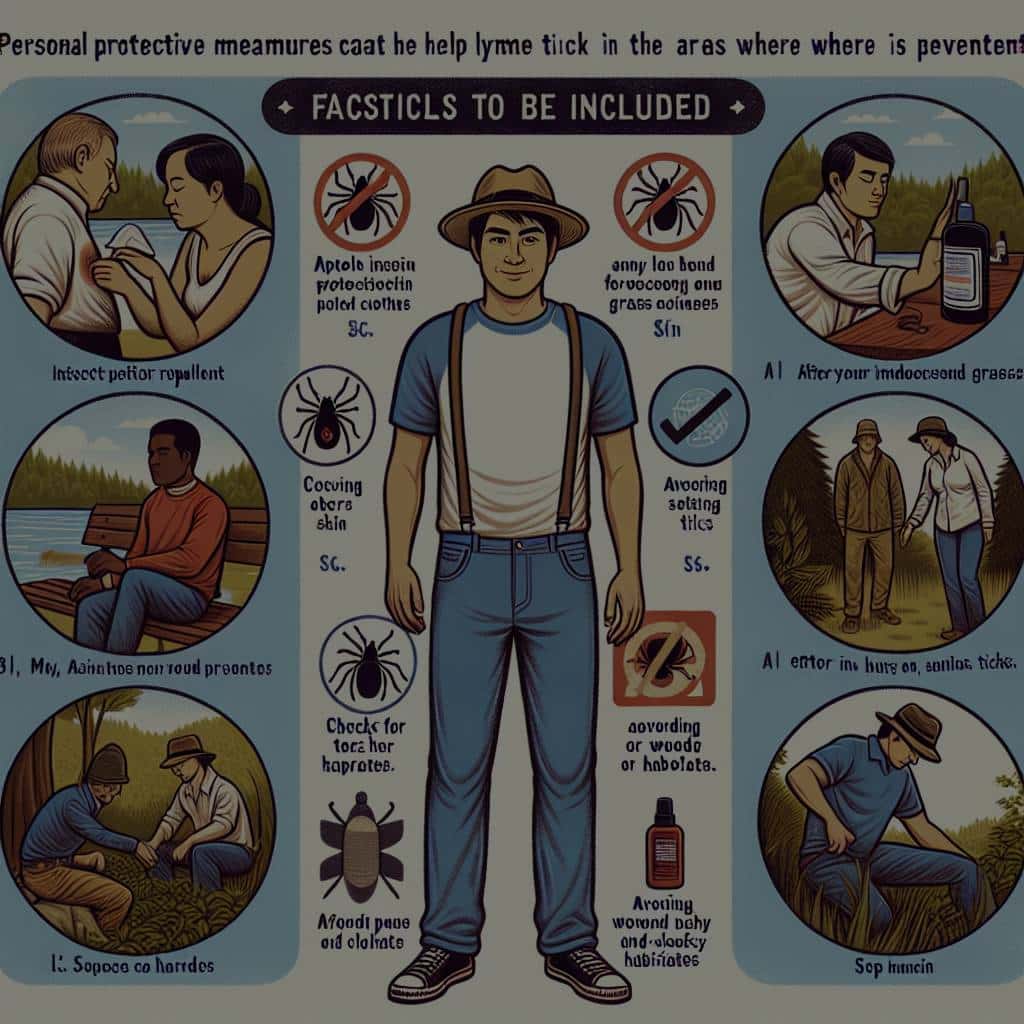What Personal Protective Measures Can Reduce Lyme Disease Risk in Endemic Areas?

When you reside in an area where ticks are prevalent, particularly the Ixodes scapularis tick, commonly known as the black-legged or deer tick, your risk of Lyme disease increases significantly. Lyme disease, caused by the bacterium Borrelia burgdorferi, is primarily transmitted to humans through the bite of infected nymphs, immature ticks. The data on Lyme disease is quite alarming, with the Centers for Disease Control and Prevention (CDC) reporting an estimated 300,000 cases each year in the United States alone.
Dr. Jordan Schulze, a well-respected researcher in the field of tick-borne diseases, has dedicated his career to studying the control of ticks and reducing the risk of Lyme disease. He suggests that personal protective measures are a vital part of reducing the risk of Lyme disease in endemic areas. In the following sections, we’ll delve into these measures, exploring how you can protect yourself from the high risk of Lyme disease.
In parallel : How Can Speech Recognition Technology Assist Patients Recovering from a Stroke?
Understanding Your Risk
Before implementing protective measures, it’s essential to first understand the risk. Ticks are not distributed evenly across all regions. They are typically found in grassy and heavily wooded areas, making residences near these environments high risk. Deer ticks specifically are common in the northeastern and upper midwestern United States.
Understand that ticks are most active from April to September. However, they can also be active in winter if the temperature is above freezing. According to Schulze, the nymph stage is the most dangerous because nymphs are tiny and their bite is often painless, making it easy for them to feed unnoticed for several days. This prolonged feeding time increases the chances of the Lyme disease bacterium being transmitted.
Also read : How Can Antioxidant-Rich Diets Prevent Age-Related Eye Diseases?
Personal Protective Measures
Taking precautions to avoid tick bites can make a significant difference in your risk of contracting Lyme disease. Dressing appropriately when in tick-infested areas can serve as a protective barrier. Schulze recommends light-colored clothing to make it easier to see ticks. He also suggests wearing long-sleeved shirts and long pants tucked into socks or boots, as ticks often latch onto the skin near the ground and crawl upward.
Using a tick repellent is another effective measure. Products containing DEET can be applied directly to the skin, while permethrin-based sprays can be used on clothing and outdoor gear. It’s important to follow the product instructions carefully to ensure maximum protection.
Residential Risk Management
Even within your own residential area, there are steps you can take to control the tick population and reduce your Lyme disease risk. Schulze’s studies have shown that maintaining a well-trimmed lawn and clear yard can significantly reduce the number of ticks. Avoiding overgrown grass and leaf litter, and keeping play equipment, decks, and patios away from yard edges and trees can also help.
Another measure is the use of pesticide control, which, although controversial, can be highly effective when used appropriately. Schulze advises considering a professional pesticide application, especially in high-risk areas. A single application of acaricide, a tick-killing pesticide, in late spring can reduce the population of nymphs by up to 68%.
Early Detection and Treatment
The sooner Lyme disease is detected, the more effectively it can be treated. Schulze emphasizes the importance of conducting a thorough tick check after spending time in wooded or grassy areas. Pay special attention to the underarms, in and around the ears, inside the belly button, behind the knees, between the legs, around the waist, and especially in the hair.
If you find a tick, remove it as soon as possible. Use fine-tipped tweezers, grasp the tick close to the skin, and pull upward with steady pressure. Avoid twisting or jerking as this can cause the mouthparts to break off and remain in the skin. Once the tick is removed, clean the bite area with rubbing alcohol or soap and water.
If you develop a rash, fatigue, chills, fever, headache, muscle and joint aches, or swollen lymph nodes within 30 days of a tick bite, seek medical attention immediately. Lyme disease can be treated effectively with antibiotics, especially if treatment is started early.
Community-Based Interventions
Schulze also emphasizes the role of community-based interventions in reducing Lyme disease risk. These may include public education campaigns to raise awareness about ticks and Lyme disease, and neighborhood-wide pesticide applications. Subsidized tick control services and the promotion of landscaping practices that deter deer, the main host for adult ticks, can also contribute to a lower risk of Lyme disease in high-risk residential areas.
Ultimately, it is a combination of these personal protective measures, early detection and treatment, residential risk management, and community-based interventions that offer the most effective protection against Lyme disease. By staying vigilant and taking these comprehensive steps, you can significantly reduce your risk of Lyme disease in tick-endemic areas.
The Role of Wildlife in Lyme Disease Transmission
Having an understanding of the role that wildlife plays in Lyme disease transmission can further equip you in your efforts to protect yourself. In the realm of tick-borne diseases, Dr. Schulze’s research highlights the importance of understanding the relationships between ticks, their wildlife hosts, and the risk of Lyme disease to humans.
Ticks, as we know, are the primary vectors of Lyme disease. However, they do not act in isolation; instead, they are part of a complex ecosystem that involves a variety of host species. The deer tick, for instance, requires a blood meal at each stage of its life cycle, and these meals are usually obtained from specific wildlife hosts. Host-seeking nymphs often latch onto white-footed mice, birds, and reptiles, while adult ticks frequently select larger hosts like deer.
The role of mice in the transmission of Lyme disease is particularly significant. Dr. Schulze’s studies underscore that the white-footed mouse is a highly effective reservoir of Borrelia burgdorferi, the bacterium responsible for Lyme disease. This means that when a tick feeds on an infected mouse, it becomes a potential carrier of Lyme disease.
Additionally, the presence of deer in residential areas can also heighten the risk of Lyme disease. Deer serve as the primary reproductive host for adult deer ticks, contributing to the proliferation of tick populations in the environment. Effective protective measures, therefore, could include strategies that deter these animals from your property, alongside regular yard maintenance and careful personal protective measures.
Conclusion
Lyme disease, as we have come to understand, is a complex public health issue that necessitates a multifaceted approach. By staying informed on the prevalence of ticks in your area, adopting personal protective measures, managing risks within your residential area, and understanding the role of wildlife in Lyme disease transmission, you can significantly reduce your risk of contracting this disease.
It’s crucial to remember to always conduct thorough tick checks after spending time outdoors, especially in wooded or grassy areas. Early detection and prompt treatment of Lyme disease significantly improve treatment outcomes. Furthermore, community-based interventions such as public education campaigns, neighborhood-wide pesticide applications, and subsidized tick control services are also critical components in the fight against Lyme disease.
Dr. Schulze’s research underscores the importance of these strategies in reducing Lyme disease risk. It is a testament to the importance of ongoing research in tick-borne diseases and the role it plays in informing and shaping preventive strategies. Awareness, caution, and active preventive measures are our best bet in mitigating the risk of Lyme disease. As we continue to learn more about Lyme disease, we can better protect ourselves and our communities.
